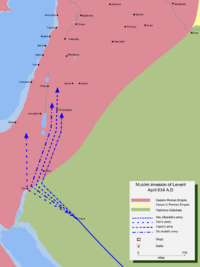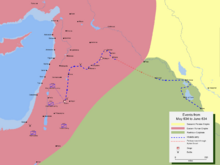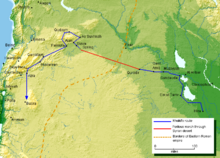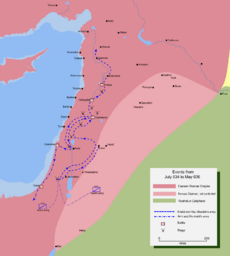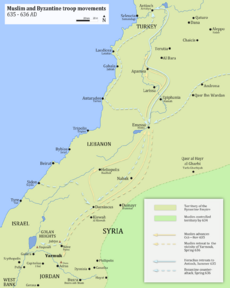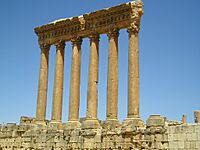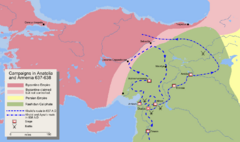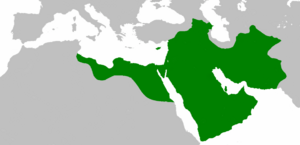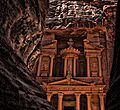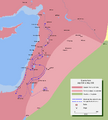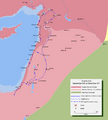Muslim conquest of the Levant facts for kids
Quick facts for kids Muslim conquest of the Levant |
|||||||||
|---|---|---|---|---|---|---|---|---|---|
| Part of the Arab–Byzantine wars | |||||||||
 Scene of the Roman Theatre at Palmyra, 2005 |
|||||||||
|
|||||||||
| Belligerents | |||||||||
| Rashidun Caliphate | Byzantine Empire Ghassanids Tanukhids |
||||||||
| Commanders and leaders | |||||||||
|
|||||||||
The Muslim conquest of the Levant was a big invasion of Byzantine Syria by the Rashidun Caliphate. This happened between 634 and 638 CE. The Levant is a historical area in the Middle East. It includes modern-day Syria, Lebanon, Jordan, Palestine, and Israel. This conquest was part of the larger Arab–Byzantine wars. After the conquest, the Levant became part of the Arab Muslim empire. It was then known as the region of Bilad al-Sham.
Small fights between Arabs and Byzantines happened even when Muhammad was alive. One such fight was the Battle of Mu'tah in 629 CE. But the main conquest started in 634 CE. This was two years after Muhammad's death. The first two Rashidun caliphs, Abu Bakr and Umar ibn al-Khattab, led this conquest. During this time, Khalid ibn al-Walid was a very important leader of the Rashidun army.
Contents
Syria Under Roman Rule
For about 700 years before the Muslim conquest, Syria was ruled by the Romans. The Sassanid Persians invaded Syria many times. This happened in the 3rd, 6th, and 7th centuries. The Sassanids' Arab friends, the Lakhmids, also raided the area.
After Jerusalem fell in 70 CE, the Romans renamed the whole region. It became known as Palaestina. This area included Judea, Samaria, and Galilee. The Romans also renamed parts of the Negev and Sinai. They called this area Palaestina Salutaris. Part of this land was ruled by the Ghassanids. They were an Arab group allied with the Romans.
In the early 7th century, the Persians took over Syria, Palestine, and Egypt. This lasted for more than ten years. But the Byzantine Emperor Heraclius won battles and forced the Persians to make peace in 628 CE. So, when the Muslims arrived, the Byzantines were still trying to get back control of these lands. Some areas had been lost for almost 20 years.
Syria had many people who spoke Aramaic and Greek. There were also some Arabs, especially in the east and south. The Ghassanid tribe moved from Yemen to Syria. They became Christians. They ruled a state that was semi-independent but still under Roman control. Their king ruled the Arabs in Jordan and Southern Syria from Bostra. The last Ghassanid king during the Muslim invasion was Jabalah ibn al-Aiham.
Emperor Heraclius set up new defense lines. These lines went from Gaza to the Dead Sea. They were mostly to protect against bandits. Most of the Byzantine defenses were in Northern Syria. They faced the Persians there. This left the south open. So, the Muslims could advance from the desert and reach Gaza easily.
The 7th century was a time of big military changes for the Byzantine Empire. The empire was not collapsing. But it was tired from recent wars with the Persians. It struggled to deal with the new challenge from Arabia.
The Rise of the Caliphate
Fights with the Byzantine Empire began when Muhammad was still alive. The Battle of Mu'tah happened in September 629. It was near the village of Mu'tah, east of the Jordan River. This battle was between Muhammad's forces and the Byzantine Empire. The Byzantines were helped by their Arab Christian allies, the Ghassanids.
Islamic history says the Muslims wanted revenge. A Ghassanid official had killed Muhammad's messenger. The Muslim army was defeated in this battle. After three Muslim leaders died, Khalid ibn al-Walid took command. He managed to save the rest of the army. The surviving Muslim forces went back to Medina.
After his last pilgrimage in 632, Muhammad chose Usama ibn Zayd to lead an army. This army was to invade the Balqa region in the Byzantine Empire. This was called the Expedition of Usama bin Zayd. Its goal was to get revenge for the Muslim losses at the Battle of Mu'tah. Usama's father had been killed there. Usama's expedition in May/June 632 was successful. His army was the first Muslim force to raid Byzantine land successfully.
Muhammad died in June 632. Abu Bakr became the new Caliph and leader in Medina. Soon after Abu Bakr became Caliph, some Arab tribes rebelled. These were called the Ridda wars (Wars of Apostasy). These wars ended in 633. By then, Arabia was united under the Caliph in Medina.
It's hard to say if Abu Bakr planned a full conquest. But he started something huge. In just a few decades, it would become one of the largest empires in history. It began with a fight against the Persian Empire. The general Khalid ibn al-Walid led this fight.
The Expedition to Syria
After winning battles against the Sassanids, Khalid set up his base in Iraq. He also fought the Ghassanids there. Medina then gathered soldiers from all over the Arabian peninsula. Only those who had rebelled in the Ridda wars were not allowed to join. This lasted until 636. At that time, Caliph Umar needed more soldiers for the Battle of Yarmouk and the Battle of al-Qādisiyyah.
Abu Bakr divided the army into four groups, called corps. Each corps had its own commander and goal.
- Amr ibn al-A'as: His goal was Palestine. He would move through Elat and the Valley of Arabah.
- Yazid ibn Abu Sufyan: His goal was Damascus. He would move through Tabuk.
- Shurahbil ibn Hasana: His goal was Jordan. He would follow Yazid on the Tabuk route.
- Abu Ubaidah ibn al-Jarrah: His goal was Emesa. He would follow Shurahbil on the Tabuk route.
Abu Bakr did not know where the Byzantine army was. So, he told all the corps to stay in touch. This way, they could help each other if the Byzantines gathered their army. If they had to fight one big battle, Abu Ubaidah would be the main commander.
In early April 634, the Muslim armies left Medina. Yazid's corps left first. Then Shurahbil, Abu Ubaidah, and Amr followed, one day apart.
Conquering Syria
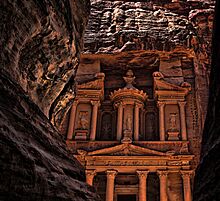
First Steps
Yazid's army moved towards its target past Tabouk. They met a small Christian Arab force. This force was retreating after a small fight. Yazid then went to the Valley of Arabah, near the Dead Sea.
The main Byzantine defense line started near Ghazahh. Yazid reached the Valley of Araba at the same time Amr bin Al Aas reached Elat. The Byzantines sent small groups to stop Yazid's and Amr's armies. These groups were easily defeated. But they did stop the Muslim forces from reaching their exact goals. Abu Ubaidah and Shurhabil kept marching. By early May 634, they were between Bosra and Jabiya.
Emperor Heraclius learned about the Muslim armies from his Arab allies. He started planning how to fight back. Heraclius ordered Byzantine forces to gather at Ayjnadyn. From there, they could fight Amr's army. They could also attack the other Muslim armies in Jordan and Southern Syria. The Byzantine army was estimated to be about 100,000 strong.
Abu Ubaidah told the Caliph about the Byzantine plans in late May 634. Abu Ubaida was not very experienced in leading such big battles. So, Abu Bakr decided to send Khalid ibn Walid to take command. Abu Bakr reportedly said, "By Allah, I shall destroy the Romans and the friends of Satan with Khalid Ibn Al Walid."
Khalid quickly left Al-Hirah, in Iraq, in early June. He took half of his army, about 8000 soldiers. There were two main roads to Syria from Iraq. Khalid needed to get to Syria quickly to help the Muslim armies. So, he chose a shorter, unusual route through the Syrian Desert. His soldiers marched for two days without water. They finally reached a water source at an oasis. Khalid entered Northern Syria this way. He surprised the Byzantines on their right side. Historians say this clever move broke the Byzantine defenses in Syria.
Southern Syria Battles
Several cities fell to Khalid first. These included Ain Tamer, Quraqir, Suwa, Arak, and the ancient city of Tadmur. Sukhnah, al-Qaryatayn and Hawarin were captured after battles. After these victories, Khalid moved towards Damascus. He went through a mountain pass. This pass is now called Sanita-al-Uqab.
From there, he went towards Bosra, the capital of the Ghassanids. He told other Muslim commanders to bring their armies to Bosra. At Maraj-al-Rahab, Khalid quickly defeated a Ghassanid army. This was called the Battle of Marj-al-Rahit. Meanwhile, Abu Ubaida ibn al-Jarrah had ordered Shurhabil ibn Hasana to attack Bosra. Shurhabil besieged Bosra with his small army of 4000.
The Roman and Ghassanid Arab soldiers in Bosra attacked Shurhabil. They surrounded him. But Khalid arrived with his cavalry and saved Shurhabil. Khalid, Shurhabil, and Abu Ubaidah then continued the siege of Bosra. The city surrendered in mid-July 634 CE. This ended the Ghassanid Dynasty.
Khalid then took command of the Muslim armies in Syria from Abu Ubaidah. This was as the Caliph had ordered. Huge Byzantine armies were gathering at Ajnadayn. They wanted to push the invaders back to the desert. Early Muslim sources say the Byzantine army was 90,000 strong. Modern historians doubt this number. But they agree this battle was key to breaking Byzantine power in Syria.
Khalid told all Muslim groups to gather at Ajnadayn. There, they won a decisive battle against the Byzantines on July 30. This defeat left Syria open to the Muslim invaders. Khalid decided to capture Damascus, a strong Byzantine city. Thomas, the son-in-law of Emperor Heraclius, was in charge of Damascus. He heard Khalid was coming. So, he prepared the city's defenses. He also asked Emperor Heraclius in Emesa for more soldiers.
Thomas sent armies to slow down Khalid's march. One army was defeated at the Battle of Yaqusa in mid-August. This was near Lake Tiberias. Another was defeated in the Battle of Maraj as Saffer on August 19. These fights did slow Khalid down. This gave Thomas time to prepare for a siege.
Khalid reached Damascus on August 20. He began his siege. To cut off the city, Khalid placed soldiers on roads leading to Palestine and Emesa. Heraclius's extra soldiers were stopped and defeated. This happened at the Battle of Sanita-al-Uqab, 30 kilometers from Damascus. Khalid's forces fought off three Roman attacks.
Khalid finally attacked and conquered Damascus on September 18. The siege lasted 30 days. Some sources say it lasted four or six months. Heraclius heard Damascus had fallen. He left Emesa for Antioch. The people of Damascus were given peace. They promised to pay a yearly tax. The Byzantine army was given three days to leave. After three days, Khalid took his cavalry. He used a shortcut and caught up to the Romans. He attacked them at the Battle of Maraj-al-Debaj, 305 kilometers north of Damascus.
Conquest Under Caliph Umar
Khalid's New Role
On August 22, Abu Bakr, the first caliph, died. He had chosen Umar as his successor. Umar's first action was to remove Khalid from command. He appointed Abu Ubaidah ibn al-Jarrah as the new commander-in-chief. Abu Ubaidah received this news during the siege of Damascus. But he waited to announce it until the city was conquered. Later, Khalid promised to be loyal to the new Caliph. He continued to serve as a regular commander under Abu Ubaidah. He reportedly said, "If Abu Bakr is dead and Umar is Caliph, then we listen and obey."
Abu Ubaidah moved more slowly and carefully. This affected the military operations in Syria. Abu Ubaidah admired Khalid. He made Khalid commander of the cavalry. He also relied a lot on Khalid's advice during the whole campaign.
Taking Central Levant
After becoming commander, Abu-Ubaidah sent a small group to a yearly fair. This fair was at Abu-al-Quds, now Ablah, near Zahlé. There was a Byzantine and Christian Arab military group nearby. But the Muslim spies misjudged its size. The garrison quickly surrounded the small Muslim group. But before it was destroyed, Khalid came to help. Abu Ubaidah had sent Khalid after getting new information. Khalid reached the battle and defeated the garrison on October 15. He returned with lots of goods from the fair and many Roman prisoners.
By capturing central Syria, the Muslims greatly hurt the Byzantines. Communication between Northern Syria and Palestine was cut off. Abu Ubaidah decided to march to Fahl. This place is about 150 meters below sea level. A strong Byzantine garrison was there, along with survivors from the Battle of Ajnadayn. This area was important. From here, the Byzantine army could attack east. They could cut off Muslim communication with Arabia. Also, with this large garrison behind them, Palestine could not be invaded.
Khalid, leading the advance group, reached Fahl first. He found that the Byzantines had flooded the plains. They did this by blocking the River Jordan. The Byzantine army was defeated at the Battle of Fahl on January 23, 635.
Conquering Palestine
Next, the Muslim armies secured their control of the Levant. Shurhabil and Amr went deeper into Palestine. Bet She'an surrendered quickly. Then Tiberias surrendered in February. Umar learned about the Byzantine army in Palestine. He sent detailed orders to his commanders there. He told Yazid to capture the Mediterranean coast.
Amr and Shurhabil marched against the strongest Byzantine garrison. They defeated them in the Second Battle of Ajnadyn. The two armies then split up. Amr went to capture Nablus, Amawas, Jaffa, Haifa, Gaza and Yubna. This completed the conquest of all Palestine. Shurahbil went against the coastal towns of Acre and Tyre. Yazid advanced from Damascus. He captured the ports of Sidon, Arqa, Byblos and Beirut.
By 635 CE, Palestine, Jordan, and Southern Syria were in Muslim hands. Only Jerusalem and Caesarea were not. Umar ordered Yazid to besiege Caesarea. This siege lasted until the port fell in 640. It was paused around the time of the Battle of Yarmouk.
According to a writer named David ben Abraham al-Fasi, the Muslim conquest helped the Jewish people in Palestine. The Byzantines had stopped them from praying on the Temple Mount. But the Muslims allowed them to do so.
Battles for Emesa and Second Battle of Damascus
After the Battle of Fahl, the Muslim armies split. Shurhabil and Amr's armies went south to capture Palestine. Abu Ubaidah and Khalid, with a larger army, went north to conquer Northern Syria.
While the Muslims were busy at Fahl, Heraclius saw a chance. He quickly sent an army under General Theodras. Their goal was to recapture Damascus. A small Muslim group was left there. Soon after, the Muslims, having won at Fahl, were on their way to Emesa. The Byzantine army split into two. One part was at Maraj al Rome, led by Schinos. The other, led by Theodras, was west of Damascus.
During the night, Theodras moved towards Damascus for a surprise attack. Khalid's spy told him about this. Khalid got permission from Abu Ubaidah. He quickly rode to Damascus with his mobile guard. Abu Ubaidah fought and defeated the Roman army in the Battle of Marj ar-Rum. Khalid went to Damascus with his cavalry. He attacked and defeated Theodras there. A week later, Abu Ubaida went to Heliopolis. This city had the great Temple of Jupiter.
In May 636, Heliopolis surrendered to the Muslims easily. They agreed to pay tribute. Abu Ubaidah sent Khalid straight to Emesa. Emesa and Chalcis offered a peace treaty for a year. Abu Ubaidah accepted. Instead of invading these areas, he made his rule stronger in the lands he had already conquered. He captured Hamah and Maarrat al-Nu'man.
Heraclius gathered large armies at Antioch. He sent them to important areas in Northern Syria, like Emesa and Chalcis. This Byzantine reinforcement of Emesa broke the treaty. So, Abu Ubaidah and Khalid marched there. A Byzantine army that tried to stop Khalid was defeated. The Muslims besieged Emesa. It was finally conquered in March 636 CE after two months.
The Battle of Yarmouk
After taking Emesa, Khalid moved north to capture Northern Syria. He used his cavalry to raid ahead. At Shaizar, Khalid stopped a group carrying supplies for Chalcis. He questioned the prisoners. They told him about Emperor Heraclius's big plan. Heraclius wanted to take back Syria with an army of possibly 200,000 soldiers. Khalid immediately stopped his raid.
Heraclius had learned from past defeats. He now avoided big open battles with the Muslim army. His plan was to send many soldiers to major cities. He wanted to separate the Muslim armies. Then he would surround and destroy them one by one.
Part of his plan was to work with Yazdgerd III, the Sassanid emperor. In 635, Yazdgerd III tried to make an alliance with Heraclius. Heraclius's daughter married Yazdgerd III. Heraclius prepared for a big attack in the Levant. Yazdegerd was supposed to attack on his front in Iraq at the same time. But this did not happen.
Umar probably knew about this alliance. He started peace talks with Yazdegerd III. He even invited him to join Islam. When Heraclius attacked in May 636, Yazdegerd could not help. His government was too tired from wars. This ruined Heraclius's plan.
Five huge armies were sent in June to take back Syria. Khalid understood Heraclius's plan. He worried the Muslim armies would be separated and destroyed. So, he suggested to Abu Ubaidah that they gather all Muslim armies in one place. This would force a big battle with the Byzantines. Abu Ubaidah agreed. They gathered at Jabiya. This move greatly hurt Heraclius's plan. He did not want to fight an open battle with the Muslim cavalry.
From Jabiya, Abu Ubaidah ordered the Muslim troops to move to the Yarmouk River plain. Khalid suggested this. The cavalry could fight well there. While the Muslim armies gathered at Yarmouk, Khalid stopped and defeated the Byzantine advance guard. This made sure the Muslim army could retreat safely.
The Muslim armies reached the plain in July. About a week or two later, in mid-July, the Byzantine army arrived. The Byzantine commander, Vahan, sent Ghassanid forces to check the Muslim strength. Khalid's mobile guard defeated them. This was the last action before the main battle. For one month, talks continued between the two armies. Khalid even met Vahan in person. Meanwhile, Muslim reinforcements arrived from Umar.
Abu Ubaidah held another meeting. He gave Khalid command of the Muslim army in the field. Finally, on August 15, the Battle of Yarmouk was fought. It lasted six days. It was a huge defeat for the Byzantines. This battle ended Byzantine control of the Levant forever.
Meanwhile, Umar kept Yazdegerd III busy with a trick. Yazdegerd III lost his army at the Battle of Qadisiyyah in November. This was three months after Yarmouk. It ended Sassanid control west of Persia.
Taking Jerusalem
With the Byzantine army defeated, the Muslims quickly took back the land they had conquered before Yarmouk. Abu Ubaida met with his commanders, including Khalid. They decided to conquer Jerusalem. The Siege of Jerusalem lasted four months. The city agreed to surrender. But they would only surrender to Umar himself.
Amr-bin al-Aas suggested that Khalid should pretend to be the caliph. This was because Khalid looked a lot like Umar. But Khalid was recognized. So Umar had to come himself to accept Jerusalem's surrender in April 637.
Umar appointed his close advisor Ali to be in charge of Medina. After Jerusalem, the Muslim armies split again. Yazid's army went to Damascus. Then they captured Beirut. Amr and Shurhabil's armies went to conquer the rest of Palestine. Abu Ubaidah and Khalid, with 17,000 soldiers, moved north to conquer Northern Syria.
Conquering Northern Syria
Emesa was already captured. So Abu Ubaidah and Khalid moved towards Chalcis. This was a very important Byzantine fort. Through Chalcis, the Byzantines could protect Anatolia, Heraclius's home of Armenia, and the capital, Antioch.
Abu Ubaidah sent Khalid with his mobile guard towards Chalcis. The fort was very strong. It was guarded by Greek soldiers led by Menas. Menas was said to be second only to the Emperor in importance. Menas decided to fight Khalid outside the fort. He wanted to destroy the first Muslim soldiers before the main army arrived. This happened at Hazir, 5 kilometers east of Chalcis. The Battle of Hazir was so impressive that Umar reportedly praised Khalid. He said, "Khalid is truly the commander. May Allah have mercy upon Abu Bakr. He was a better judge of men than I have been."
Abu Ubaidah soon joined Khalid at Chalcis. The city surrendered in June. With this important victory, the land north of Chalcis was open to the Muslims. Khalid and Abu Ubaidah kept marching north. They besieged Aleppo. It was captured in October after strong resistance from the Byzantine soldiers.
Before marching to Antioch, Khalid and Abu Ubaidah decided to cut off the city from Anatolia. They sent soldiers north to clear out any Byzantine forces. They captured the town of Azaz, 50 kilometers from Aleppo. From there, Muslims attacked Antioch from the east. This led to the Battle of Iron bridge. The Byzantine army, made of survivors from Yarmouk and other Syrian battles, was defeated. They retreated to Antioch. The Muslims then besieged the city.
Antioch had little hope of help from the Emperor. It surrendered on October 30. All Byzantine troops were allowed to leave safely for Constantinople. Abu Ubaidah sent Khalid north. He himself marched south. He captured Tartus, Jablah, and finally Latakia and the coastal areas west of the Anti-Lebanon Mountains.
Khalid moved north and raided land as far as the Kızılırmak River in Anatolia. Emperor Heraclius had already left Antioch for Edessa before the Muslims arrived. He then set up defenses in Jazirah and Armenia. Then he left for Constantinople. On his way, he barely escaped Khalid. Khalid had just captured Marash. He was heading south towards Manbij. Heraclius quickly took a mountain path. As he passed through the Cilician gates, he reportedly said, "Farewell, a long farewell to Syria, my fair province. Thou art an infidel's (enemy's) now. Peace be with you, O, Syria – what a beautiful land you will be for the enemy hands."
Byzantine Counterattack
After the big defeat at Yarmouk, the rest of the Byzantine empire was weak. They had few soldiers left. They could not try to take back Syria by force. To gain time to defend the rest of his empire, Heraclius needed the Muslims to be busy in Syria. So, he asked for help from the Christians of Jazirah. These were mainly from Circesium and Hīt. They gathered a large army and marched against Emesa, Abu Ubaidah's main base.
Abu Ubaidah pulled all his soldiers from northern Syria back to Emesa. The Christians then started a siege. Khalid wanted to fight an open battle outside the fort. But Abu Ubaidah asked Umar for advice. Umar sent soldiers from Iraq to invade Jazirah from three different ways. Another group was sent to Emesa from Iraq. This group was led by Qa’qa ibn Amr, a veteran of Yarmouk. Umar himself marched from Medina with 1,000 men.
In 638, Muslims attacked Hīt. They found it well-fortified. So, they left a small part of the army to besiege the city. The rest went after Circesium. When the Christians heard about the Muslim invasion of their homeland, they stopped the siege. They quickly went back home. At this point, Khalid and his mobile guard came out of the fort. They attacked the Christian army from behind and defeated them. In late 638, Ibn Walid also captured Germanicia.
Umar ordered Sa'd ibn Abi Waqqas, the Muslim commander in Iraq, to send an army. This army, led by Iyad ibn Ghanm, was to conquer the area between the Tigris and Euphrates rivers up to Urfa. In 639–640, Raqqa fell to the Muslims. Most of Jazirah, the last Byzantine base in the region, surrendered peacefully. They agreed to pay Jizya, a tax paid by non-Muslims.
Campaigns in Armenia and Anatolia
The conquest of Jazirah was finished by 640 CE. After that, Abu Ubaidah sent Khalid and Iyad ibn Ghanm to invade Byzantine land further north. They marched separately. They captured Edessa, Amida, Melitene (Malatya) and all of Armenia up to Ararat. They also raided northern and central Anatolia. Heraclius had already left all the forts between Antioch and Tartus. He did this to create a safe area between Muslim lands and Anatolia.
Umar then stopped the expedition. He ordered Abu Ubaidah, who was now governor of Syria, to make his rule stronger there. This decision was made because Khalid was removed from the army. This ended his military career. Also, there was a drought followed by a plague the next year.
Under Caliph Uthman's Rule
During the rule of Caliph Uthman, Constantine III decided to take back the Levant. This land had been lost to the Muslims during Umar's rule. A full invasion was planned. A large army was sent to reconquer Syria. Muawiyah I, the governor of Syria, asked for more soldiers. Uthman ordered the governor of Kufa to send a group. This group, with the local soldiers, defeated the Byzantine army in Northern Syria.
In 645–646, Sufyan bin Mujib Al-Azdi, chosen by Muawiyah, managed to take Tripoli. This helped capture the last Byzantine stronghold on the Levantine coast.
Uthman gave Muawiyah permission to build a navy. From their base in Syria, the Muslims used this fleet. They captured Cyprus in 649, then Crete, and Rhodes. Yearly raids into western Anatolia stopped the Byzantines from trying to take back Syria. In 654–655, Uthman ordered an expedition to capture Constantinople. But there was unrest in the caliphate. This led to his assassination in 655. So the expedition was delayed for decades. It was only tried later, but failed.
How the Rashidun Caliphate Ruled
The new Muslim rulers divided Syria into four areas called junds. These were Jund Dimashq (Damascus), Jund Hims, Jund al-Urdunn (Jordan), and Jund Filastin (Palestine). Later, a fifth, Jund Qinnasrin, was added. The Arab soldiers stayed in separate camps. Life for the local people went on much as before. The Muslims allowed Jews and Christians to practice their religions.
Two main taxes were put in place. The kharaj was paid by landowners and farmers. It depended on how much their fields produced. The jizya was paid by non-Muslims. In return, they received protection from the state and did not have to serve in the military. The Byzantine government workers stayed in their jobs. This lasted until a new system could be set up. So, Greek remained the language used for government for over 50 years after the conquests.
The Rise of the Umayyads
A civil war broke out in the Muslim empire. This happened after Uthman was murdered. Ali was then chosen as caliph. The Rashidun Caliphate was replaced by the Umayyad dynasty. Syria became its most important region. Damascus became its capital for the next century.
Images for kids


